How to Clean a Washing Machine: Ultimate Cleaning Guide
-
 By
Ethan Clarke
By
Ethan Clarke
Knowing how to clean a washing machine is an essential skill for every homeowner. This household appliance, often overlooked in cleaning routines, plays a crucial role in keeping our clothes fresh and maintaining hygiene.
If neglected, your washer can become a perfect breeding ground for mold and mildew due to grime that accumulates over time. This not only affects its performance but also the cleanliness of your whole laundry room.
To prevent musty smells and other issues, understanding how to clean a washing machine properly is vital. So let’s delve into it!
 The Importance of Keeping Your Washing Machine Clean
The Importance of Keeping Your Washing Machine Clean
When it comes to the cleanliness and longevity of your clothes, one appliance plays a critical role: your washing machine. However, like any appliance in constant use, this workhorse can accumulate soap residue, grime from detergent, and hard water minerals over time.
Avoiding Common Issues with Regular Washer Cleaning
To prevent problems that result in less efficient wash cycles or potential fabric damage due to harsh agitation or incomplete rinsing, it’s a must to ensure your washer is cleaned regularly.
- Cleaning your washer helps remove buildup within the washer’s seals, which are often overlooked but play an important part in keeping excess water contained during operation (especially relevant for front loading washing machines).
- Regular washer cleaning also ensures small issues get addressed before they escalate into bigger ones – saving you money on repairs down the line.
- Additionally, washing machine cleaning improves overall functionality by removing blockages caused by accumulated debris inside pipes, etc.
What Happens When You Neglect Cleaning Your Washing Machine
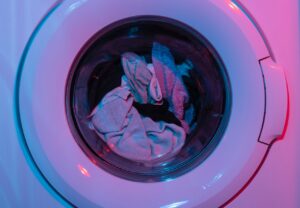 Your washer is a vital component of your home, ensuring that you and your family have clean clothes to wear every day. However, like any appliance, it requires regular cleaning to function optimally.
Your washer is a vital component of your home, ensuring that you and your family have clean clothes to wear every day. However, like any appliance, it requires regular cleaning to function optimally.
Funky smells emanating from the machine are a sign that it has been neglected for too long. These musty smells can be due to mold or mildew growth in areas like the dispenser drawer or around door seals on a front-load washer.
The growth not only creates foul smells but can also cause health issues if left unchecked.
The Impact on Performance
Neglecting routine maintenance tasks may lead to decreased performance over time due to soap residue accumulation inside drum components. Leftover laundry detergent and hard water mineral build up can also affect overall efficiency. This can result in longer cycle times and less effective stain removal capabilities.
Fabric Damage & Potential Breakdowns
Neglected machines don’t just affect cleanliness – they impact fabric quality too. Residues transferred onto fabrics during a normal cycle can cause discoloration or damage.
Additionally, lack of upkeep increases mechanical wear-and-tear leading to potential breakdowns sooner than expected.
Signs You Need to Clean Your Washing Machine
Not sure whether or not it’s time to clean your washer? Here are a few signs to look out for.
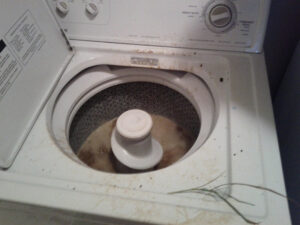 1. Unpleasant Odor
1. Unpleasant Odor
A smelly washing machine is usually the first sign that cleaning is needed. Chances are, there will be an unpleasant odor if your washer is overdue for a cleaning. This smell is caused by mold and bacteria, both of which can easily be transferred onto your clothes.
2. Black Residue
You can also tell whether or not your washer needs to be cleaned by how it looks. Check around the rubber seal on the door and the inside of the drum—do you notice any slimy residue? If so, it’s time to clean your washer.
3. Black Spots on Clothing
Always check your clothes once they’ve been washed. Are there any black spots on the fabric? If so, it might be due to leftover detergent, fabric softener or limescale, all of which can build up in hard to reach spots inside the machine.
Understanding Different Types of Washing Machines
There are two primary types of washers: top-loading machines and front-loading machines. Each comes with unique design features that dictate their cleaning requirements.
 Top-Loading Washing Machines
Top-Loading Washing Machines
The vertical drum in a top-loading washer fills up with water during the cycle. A central agitator ensures even soap distribution across your clothes throughout the washing process. However, this upright structure can lead to certain issues like soap scum buildup around the washer drum or detergent dispenser.
This accumulation hampers performance and may result in unpleasant odors over time if not addressed promptly. To save yourself some time and labor, simply run a hot cycle twice each month using ACTIVE Washing Machine Cleaner.
Front-Loading Washing Machines
In contrast to top-load models, front-load washers have a horizontal drum which uses gravity coupled with tumbling action instead of an agitator for efficient washing cycles. These units often feature a rubber gasket around the door to prevent leaks during operation.
Maintaining these areas properly after each load will help keep them dry and free from unwanted mildew buildups.
How to Clean a Washing Machine – DIY Methods
Here are some do-it-yourself methods you can try out to clean your machine using common items found around the home.
 The Power of Hot Water and Distilled White Vinegar
The Power of Hot Water and Distilled White Vinegar
One proven method involves utilizing hot water in combination with distilled white vinegar. This concoction excels at breaking down soap residue, hard water deposits, and remaining residue from leftover detergent that may have accumulated over time.
To initiate this cleaning process, fill up the drum or tub of your washer with hot water on its highest load size setting. Following this step, add two cups of distilled white vinegar into the detergent compartment along with a few tablespoons of baking soda, then run a wash cycle without any clothes inside.
This potent mix can help dissolve grime build-up, ensuring you have a clean washer ready for fresh laundry every time.
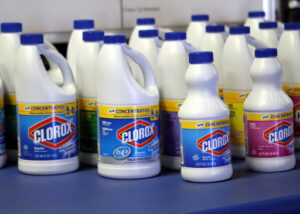 Tackling Bacteria Using Liquid Chlorine Bleach
Tackling Bacteria Using Liquid Chlorine Bleach
If white vinegar hasn’t solved, liquid bleach could offer a deeper cleanse. But remember, never combine bleach with other substances as it might result in harmful gases.
Set another cleaning cycle with warm water settings and pour one cup of liquid chlorine bleach into the detergent dispenser before running through another full cycle without clothing present.
Liquid chlorine bleach is a highly effective tool to kill bacteria and can prevent mold growth, both contributing factors towards foul smells emanating from machines. However, always ensure proper ventilation while working due to strong odors associated with bleaching agents.
Deep Cleaning with ACTIVE Washing Machine Cleaner Tablets
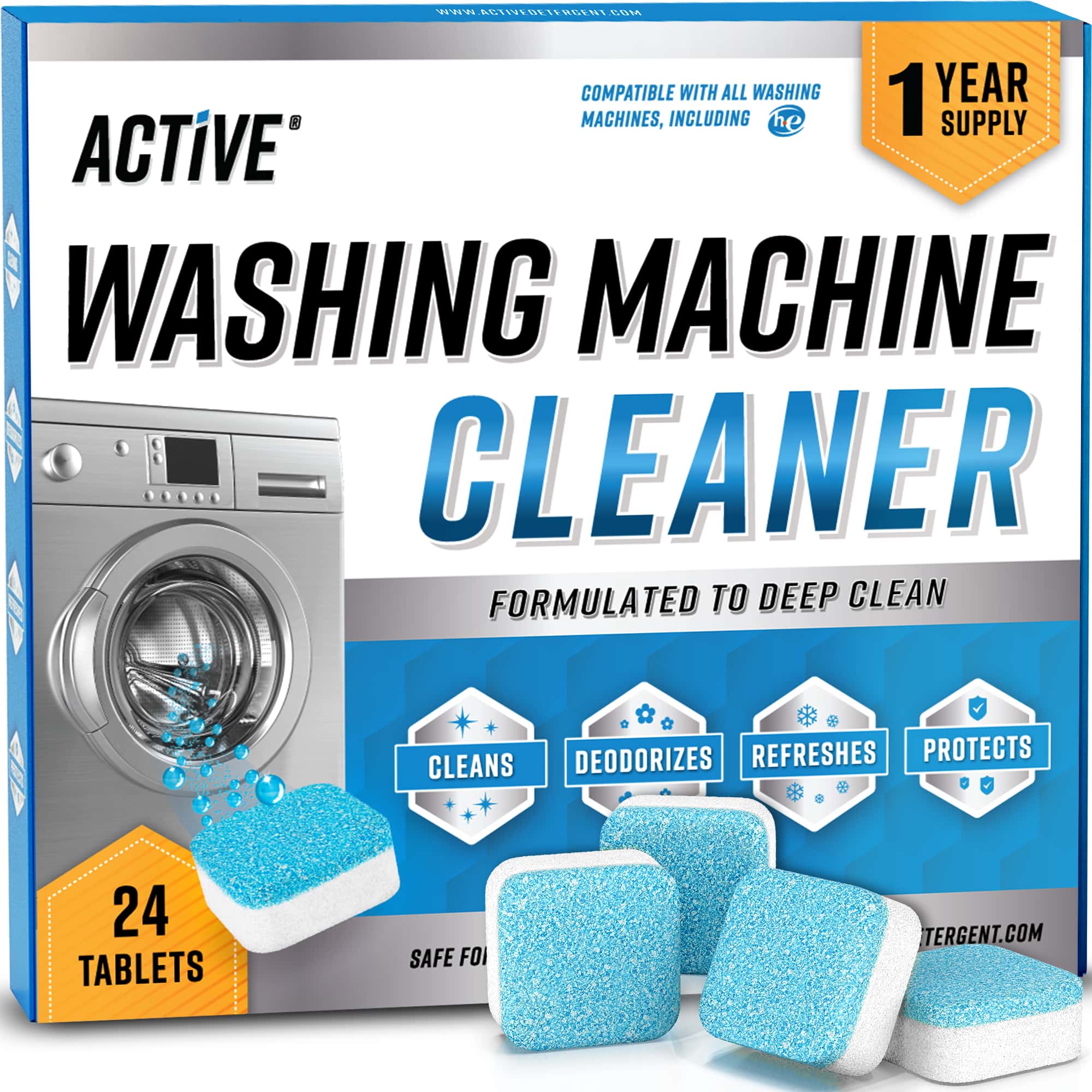 Cleaning your washer doesn’t have to be a chore. With the help of ACTIVE Washing Machine Cleaner Tablets, you can easily combat grime, soap residue, leftover detergent, and hard-water deposits that accumulate in your washer over time.
Cleaning your washer doesn’t have to be a chore. With the help of ACTIVE Washing Machine Cleaner Tablets, you can easily combat grime, soap residue, leftover detergent, and hard-water deposits that accumulate in your washer over time.
The standout feature of our cleaner tablets is their user-friendly nature. All it takes is placing one tablet into the drum of an empty washer and running a normal wash cycle (or a “tub clean” cycle, if available) using the hottest water setting.
The foaming action penetrates deep into hidden areas such as pipes or under the drum where buildup often occurs.
In addition to removing stubborn residues, ACTIVE’s cleaning formula also targets mold or mildew which may develop inside due to its damp environment. Thus eliminating unpleasant odors from within while ensuring optimal performance for every laundry load.
How Often Should Clean Your Washer with ACTIVE Tablets?
A twice-monthly usage schedule for an ACTIVE cleaning tablet is plenty for regular maintenance; however, if persistent odors persist or visible signs of residue appear on clothes post-wash, then increasing this frequency might be necessary until those issues subside.
For a first time cleaning or for very dirty machines, we recommend running two cleaning cycles with ACTIVE back-to-back. The first cycle will help loosen stubborn grime residue and the second cleaning cycle flushes it all away.
Note that front-load washers are more susceptible to developing mold around door seals, so they may require more frequent treatments compared to top-loading machines. Keeping the machine’s seals clean is crucial since these rubber gaskets can harbor mildew and other grime.
By making regular cleanings part of your routine – setting reminders twice a month and marking the handy calendar inside the box of tablets – you can help prevent costly repairs while consistently enjoying fresh laundry.
Promoting Hygiene Beyond Visible Surfaces
Cleaning isn’t always about what meets the eye. When soap scum accumulates along with leftover detergent residues from fabric softener inside our machines after each cycle, they create an ideal breeding ground for bacteria growth.
To avoid this scenario, investing some time into cleaning is worthwhile for any type of washer whether it’s a front loading machine or a top loader. Remember: An ounce of prevention now will save costly repairs later while guaranteeing fresher laundry each time.
Additional Cleaning Tips for Your Washing Machine
Maintaining your washer is essential for preserving its performance and extending its life, as well as saving money on repairs and ensuring clean laundry. Here are a few things that you can do to maintain a pristine machine between deep-cleaning sessions.
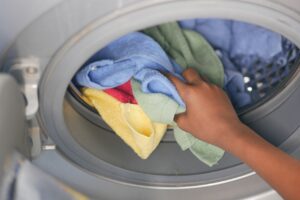 1. Don’t Leave Wet Clothes Inside
1. Don’t Leave Wet Clothes Inside
You should always take your garments out as soon as possible after the spin cycle. Whether you have a top loading washing machine or a front loader, bacteria and mold can quickly start to develop within just a few hours if the clothes are left unattended.
For this reason, you should always remove wet clothes from the washer as soon as possible. Either hang them up to air dry or put them in the dryer (assuming the care tag label says it’s ok to do so).
2. Leave the Washer Door Open When It’s Not In Use
Keeping the door of a front loading washing machine closed traps in moisture, creating the perfect environment for bacteria and mold to grow. Always leave the machine door open—that way, any excess moisture can evaporate
3. Clean the Lint Filter
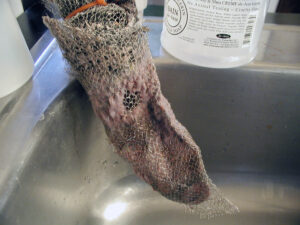 Unknown to many homeowners, most washers come with a lint trap that prevents lint from getting on your clothes. However, this filter only works properly if you keep it clean.
Unknown to many homeowners, most washers come with a lint trap that prevents lint from getting on your clothes. However, this filter only works properly if you keep it clean.
To clean your washing machine filter, you’ll first have to locate it. Depending on your washer, it might be along the top rim of the drum, at the end of the drainage hose, or inside the agitator. You can refer to your owner’s manual for the exact location.
Once you’ve found the filter, either soak it in hot water (if it’s removable), brush away the lint with a damp cloth (if it’s secured in place) or replace it (if it’s disposable). Ideally, you want to do this every three months or so.
4. Don’t Use Too Much Detergent
Contrary to popular belief, more detergent is not necessarily better. It’s actually the opposite—it can affect the performance of your washer by sticking to the sides and in crevices. Over time, detergent residue can put excess strain on moving components which can lead to damage of the motor and other parts.
You only want to use the amount of detergent that is necessary – don’t just fill the cap to the max line every time. Check the label on the bottle to see how much you should be using before you wash.
Washing Machine Cleaning FAQs
What’s the best way to clean a top loading washing machine?
There are DIY methods that involve using hot water with vinegar, baking soda or bleach that can be effective in some cases. However, using specialized cleaning tablets like ACTIVE Washing Machine Cleaner provides the most thorough clean thanks to our specific formula for washing machines.
How do I deep clean my washer myself?
You can deep clean your washer by running an empty cycle with an ACTIVE cleaning tablet. For first time cleaning or extra grimy machines, we recommend following this up with a second cleaning cycle to fully remove residue.
Is bleach or vinegar better to clean a washing machine?
Vinegar is generally safer and just as effective as bleach for regular cleaning. Bleach can be used when dealing with stubborn mold or mildew issues.
However neither of these options can compare to specially formulated solutions like ACTIVE Washing Machine Cleaner which contains multiple ingredients to target all kinds of grime and other buildup.
How do I clean the smell out of my front loading washing machine?
Cleaning front loading washers to remove odors is simple. Just run a wash cycle using an ACTIVE Washing Machine Cleaner tablet. Leave the door open between uses to allow air circulation.
Conclusion
Knowing how to properly clean a washer can make all the difference. It’s not just about aesthetics, but also about performance and longevity.
A neglected washer can lead to mold buildup, unpleasant odors, and even fabric damage.
Whether you have a top-loader or front-loader doesn’t matter. Each type has its unique cleaning needs which we’ve discussed in detail.
You learned some simple DIY methods using common household items like white vinegar, baking soda and hot water for effective cleaning. And when the situation calls for it, liquid chlorine bleach can also be effective to kill bacteria.
Beyond these methods, there are more efficient alternatives like ACTIVE Washing Machine Cleaner that works wonders on mineral deposits and soap residue among other types of grime.
Clean washers contribute to healthier home environments by preventing mold growth that could affect indoor air quality – an important consideration especially for allergy sufferers or those sensitive to mold spores.
Now that you know how to clean a washing machine, we invite you to browse what else ACTIVE has to offer. For additional home cleaning solutions and more, we’re here to make your household cleaning tasks easier and more efficient!
15% Off Amazon Coupon
×Click To Reveal The 15% Off Coupon Code For Your Entire ACTIVE Purchase At Amazon.com
Note: This promotional offer is only guaranteed through the end of the day.






Comments (15)
Is your washing machine cleaner septic safe?
Hi Karen – yes it is!
Hi there, Got the tablets. Please do I put the tablet in the center cone of the top loading machine? And do i not put clothing in if I’m using the tablet? I love that you are a small business. Might need more detailed directions in your packaging or website.
Thank you so much
Dana
Hi Dana, thanks for reaching out! Place the the tablet directly into the washer drum (the bottom of the machine). And yes, you are correct you should not have any clothes in the machine during the cleaning cycle – only the tablet. Let us know if you have any other questions, thanks again!
Hi! I just got your product today and have already run a cycle. My question is, can I use the “Tub Clean” cycle setting on my washer as well?
Yes! If your washer has a “Tub Clean” setting, we recommend using that when you run a cleaning tablet. Thank you for giving our product a try!
Why can’t I use the dishwasher product with dishes? I was looking for something to get rid of rough surface on my dishes.
Hi Kim, our dishwasher cleaning tablets designed to only clean the inside of the machine. They may damage certain types of dishes so we don’t recommend using the tablets for that purpose. Sorry about that!
My wife & I were given a front load LG washer that had been sitting for just over 2 years. Not sure how long it had been used but you can see scale in the holes in the drum and the boot was very full with soap and black gunk. We followed the directions for TUB CLEAN to add bleach to the dispensing tray and run it without anything else in the machine. It ran and huge amount of suds appeared during the 108 minute cycle. I went further and followed the procedure for replacing the rubber Boot. After removing the Boot I scrubbed and soaked the Boot in a strong mix of beach & water for 2 hours. I let it dry in the hot Texas sun and much of the smell was gone. The cleaned boot is now re-installed back on the machine and ran the “rinse & spin” cycle to be sure I reassembled the machine correctly & had no leaks. There was still much more suds in the water.
Just received your Active Washing Machine Cleaner today.
Question #1: To initially clean our used washer before regular use, How many cycles should I run with 1 tablet in each cycle to make sure it’s really clean?
Question #2: If the previous owner/user used powdered soap (we are liquid soap people), How well does your product dissolve old powdered detergent build up?
Hi Scott, apologies for the late response, we did not see your comment until now. Hopefully you’ve been able to tackle your dirty washing machine by now, but to answer your questions:
#1 – We would recommend running at least 2 cleaning cycles (each with one tablet) before use. The first cycle will loosen any stubborn grime and the second cycle will help flush any remaining residue away. Usually 2 cycles is enough for even the dirtiest machines.
#2 – ACTIVE Washing Machine Cleaner works great for dissolving powdered detergent build up! If you’ve run the two cleaning cycles, then most of the residue should be gone.
Thank you for giving our product a try!
Will the residue from using Active Washing Machine Cleaner affect a wastewater cesspool?
Can Active Washing Machine Cleaner be used in top loading washing machine without adding clothes?
Does Active Washing Machine Cleaner work best with hot water?
Hi Brenda, thanks for reaching out!
The ingredients in ACTIVE Washing Machine Cleaner are safe for most septic systems. I’m not familiar with how wastewater cesspools operate but if they can tolerate products that are rated safe for septic systems, then ACTIVE should be ok to use.
Yes, ACTIVE Washing Machine Cleaner should always be used without adding clothes so that would be fine.
And yes, we recommend using hot water for the cleaning cycle.
Thanks again!
why the big red STOP sticked that says to go to this site and read this first. Are you saying I don’t need your product to clean the washer at all?? There is no warning here saying NOT to use this tablet. i don’t get it
Hi Sue! The stop sign sticker simply directs customers to a detailed instructions page to ensure you have the most accurate instructions. We absolutely do recommend you proceed with using the product 🙂
I’ve wondered about fabric softener. It’s made to cling to the fabric, which makes me wonder if it leaves behind residue on the washing machine. If it gets on the outside and isn’t immediately wiped off, there is no removing it.